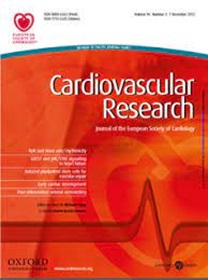Monocytes at the crossroads of aortic stenosis and myocardial damage
IF 13.3
1区 医学
Q1 CARDIAC & CARDIOVASCULAR SYSTEMS
引用次数: 0
Abstract
Aortic stenosis (AS) is the most common heart valve disease in high-income countries, causing significant morbidity and mortality. It results from progressive thickening and calcification of the aortic valve (AV) leaflets, leading to AV narrowing and myocardial remodeling - both key contributors to disease progression and symptoms. With no pharmacological treatment to slow AS, aortic valve replacement (AVR) remains the only therapeutic option for symptomatic patients. However, limited understanding of AS pathophysiology and the absence of reliable prognostic markers hinder improved patient outcomes. A comprehensive reassessment of AS pathophysiology, integrating both valvular and myocardial remodeling is essential for advancing prognostic tools and therapeutic strategies. Inflammation plays a central role in these processes, drawing increasing attention to monocytes. This review provides an updated overview of monocytes’ multifaceted involvement in AS, including: i) fibrocalcific remodeling of the valve, ii) myocardial injury during disease progression, and iii) structural valve deterioration (SVD) after surgical or transcatheter AVR. We will also discuss the potential of monocyte subsets as biomarkers for AS progression and post-AVR prognosis, as well as the therapeutic targeting of monocytes to prevent AS, SVD, and subsequent myocardial dysfunction.主动脉狭窄和心肌损伤十字路口的单核细胞
主动脉瓣狭窄(AS)是高收入国家最常见的心脏瓣膜疾病,导致显著的发病率和死亡率。它是由主动脉瓣(AV)小叶的进行性增厚和钙化引起的,导致AV变窄和心肌重构,这两者都是疾病进展和症状的关键因素。由于没有药物治疗来减缓AS,主动脉瓣置换术(AVR)仍然是有症状患者的唯一治疗选择。然而,对AS病理生理学的有限理解和缺乏可靠的预后标志物阻碍了患者预后的改善。全面重新评估AS病理生理,整合瓣膜和心肌重构对于推进预后工具和治疗策略至关重要。炎症在这些过程中起着核心作用,引起了对单核细胞越来越多的关注。这篇综述提供了单核细胞在AS中的多层面参与的最新概述,包括:i)瓣膜的纤维钙化重塑,ii)疾病进展期间的心肌损伤,以及iii)手术或经导管AVR后的结构性瓣膜恶化(SVD)。我们还将讨论单核细胞亚群作为as进展和avr后预后的生物标志物的潜力,以及单核细胞的治疗靶向预防as、SVD和随后的心肌功能障碍。
本文章由计算机程序翻译,如有差异,请以英文原文为准。
求助全文
约1分钟内获得全文
求助全文
来源期刊

Cardiovascular Research
医学-心血管系统
CiteScore
21.50
自引率
3.70%
发文量
547
审稿时长
1 months
期刊介绍:
Cardiovascular Research
Journal Overview:
International journal of the European Society of Cardiology
Focuses on basic and translational research in cardiology and cardiovascular biology
Aims to enhance insight into cardiovascular disease mechanisms and innovation prospects
Submission Criteria:
Welcomes papers covering molecular, sub-cellular, cellular, organ, and organism levels
Accepts clinical proof-of-concept and translational studies
Manuscripts expected to provide significant contribution to cardiovascular biology and diseases
 求助内容:
求助内容: 应助结果提醒方式:
应助结果提醒方式:


